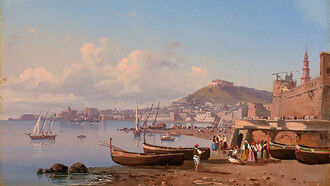The world’s largest salt flat, Salar de Uyuni, is found in southwest Bolivia. In the dry season, hexagons and other patterns form on its crusty white surface; during the rainy season, a thin layer of calm water atop the flat transforms it into the world’s largest mirror. The sky’s reflection creates a breathtaking scene and visitors appear to be walking on water there.
Reportedly, this sight is visible from the moon. The surface flatness makes the Salar an ideal object for calibrating the altimeters of the earth’s observation satellites.
The salt flat is surrounded by snow-capped mountains and volcanoes, which add to its picturesque beauty. Three species of pink flamingoes make this remnant of a prehistoric lake their home. Some of the lakes are reddish in color, creating a beautiful palette for photography.
The salt flat encompasses approximately 10,582 kilometers (4,086 square miles) and possesses a large percent of the world’s known and highly sought after lithium sources. Salar de Uyuni is located at the crest of the Andes Mountains and has an average elevation of 3,660 meters (12,000 feet) above sea level.
Most visitors to Bolivia’s salt flat arrive in La Paz, Bolivia, the highest city in the world. Multiple tour companies take visitors to the salt flat.
I can attest to the advisability of arriving a few days before a salt flat tour, as I did suffer from altitude sickness, which manifested in nausea, headaches, shortness of breath and tiredness. Sucking on cocoa leaves, drinking cocoa tea and taking prescription altitude sickness medication can alleviate these symptoms. Good sunglasses and sunscreen also are advisable, as the sun is strong and reflected on the white salt surfaces.
Join a tour to visit Uyuni and the salt flat is a good idea. The salt flat area is accessible by airplane, bus or private car. It is a nine-hour road trip from La Paz to Uyuni, which is the closest town to the salt flat. If you opt for a bus, ensure that you choose a “tourist” bus, as such buses provide more roomy and reclining seats for the journey. All of the buses are inexpensive, by western standards. A four-wheel drive vehicle is necessary for traversing the salt flat, as the roads are frequently unpaved and rocky. There are few directional signs, so guides are a must.
Many of the hotels in Uyuni are almost entirely built of salt blocks cut from the Salar. Some are fancy, with spas and other amenities. Others are quite rustic, and have electricity brownouts during certain times of the night. Reservations are advisable, as hotels on the flats are not plentiful.
There are 32 islands on the salt flat made of petrified corals, which are home to giant cacti, some of which are ten meters tall. These islands arise out of the flat terrain like oases. Some have rest stops and hiking trails. The salt flats’ unusual flatness and features attract Instagram users and photographers. Enterprising entrepreneurs set up sites with props to create entertaining photo opportunities in various places. Using perspective, one can set up shots in which people appear to slay huge dragons, ride atop dinosaurs, and more.
In certain areas of the salt flat, there are unusual rock formations that attract visitors. The most well known is called the stone tree, a slender rock formation with a large, bulbous top. Other formations in the area also are dramatic and photo-worthy. The rocks are reddish in color and carved over millennia by wind, water and rain.
There is an antique train cemetery outside of Uyuni. Train rails had been built in the late 1800s by British engineers to support mining in the area. More than one hundred trains were abandoned when the mining industry collapsed in the 1940s. The collection of corroding train locomotives and cars has become a tourist attraction. One artist created an art installation there with pieces made of recycled aluminum and metal. My favorite piece is a huge metal giraffe. Menacing looking action figures also hold visitors’ interest.
Another interesting feature of the area is the wildlife. One can see llamas, alpaca, vicuna and even wild ostrich while traveling there. A personal favorite is the viscacha, an animal that looks like a rabbit with a long curly tail, that likes to hide among rocks, but has been tamed to appear by frequent visitors. The Andean Condor, the largest bird species on the planet, also make this area home. Llama meat is frequently found on restaurant menus in Bolivia.
Geothermic features are found in an area near the salt flat called the Fumaroles of Sol de Mañana (Fumes of the Morning Sun). Fumaroles are openings in the earth’s crust that emit steam and gas. The bubbling mud pools smell like sulfur. While fumaroles are dangerous to humans who get too near, natural, mineral-rich hot springs are available for bathing at a site called the Polques Hot Springs.
The salt flats’ dramatic landscape is visually captivating and unlike any other place on earth. The grand Andean mountains frame the area. Some Chilean mountains and the Ollague volcano that marks the border between Chile and Bolivia are visible on the horizon.
Visit the canvas of geometries during the dry season, or the world’s largest mirror after the rains. They are unforgettable sights.















